Exploring Kääntäbä: A Deep Dive into Cultural Unity and Diversity
Introduction
Welcome to our extensive guide on Kääntäbä—a symbol deeply rooted in indigenous cultural contexts. In this article, we will explore the significance of Kääntäbä, its origins, its role in various rituals, and its impact on cultural unity and diversity. This guide is crafted to provide a comprehensive understanding of Kääntäbä, aiming to surpass existing online sources and deliver valuable insights for readers in the USA and beyond.
“Kääntäbä is a symbol of cultural unity and diversity, originating from indigenous traditions and used in various rituals and ceremonies to represent communal harmony and respect for diverse cultures.”
What is Kääntäbä?
Kääntäbä is a symbol representing cultural unity and diversity, originating from indigenous traditions. It embodies the rich heritage and values of indigenous communities and is often featured in various rituals and ceremonies. The term Kääntäbä encompasses a range of meanings depending on its cultural and contextual use, making it a fascinating subject for exploration.
The Origin of Kääntäbä
1.1 Historical Background
Kääntäbä has its roots in ancient indigenous cultures, where it was used as a symbol of communal harmony and spiritual connection. Its historical significance varies among different cultures, but it generally represents the interconnectedness of all life forms and the unity of diverse communities.
1.2 Cultural Significance
In indigenous traditions, Kääntäbä serves as a reminder of the cultural values and principles that guide the community. It is often associated with ceremonies that celebrate nature, ancestry, and social bonds. The symbol’s use in these contexts underscores its role in fostering a sense of belonging and collective identity.
The Symbolism of Kääntäbä
2.1 Representing Unity
Kääntäbä is a powerful symbol of unity, representing the coming together of different elements to form a harmonious whole. It embodies the idea that diversity enriches rather than divides, and it encourages the celebration of various cultural backgrounds within a unified framework.
2.2 Reflecting Diversity
Beyond its role in symbolizing unity, Kääntäbä also highlights the importance of diversity. It represents the recognition and respect for different cultural traditions and perspectives, promoting an inclusive environment where various voices and experiences are valued.
Kääntäbä in Rituals and Ceremonies
3.1 Ritual Use
In many indigenous cultures, Kääntäbä is an integral part of rituals and ceremonies. It is often used in sacred spaces to invoke spiritual connections and to honor the natural world. The symbol’s presence in these rituals underscores its spiritual significance and its role in reinforcing cultural values.
3.2 Ceremonial Significance
Kääntäbä’s use in ceremonies often involves its display in art, clothing, or ceremonial objects. Its inclusion in these practices serves to reinforce the community’s cultural identity and to foster a deeper connection with their heritage.
The Impact of Kääntäbä on Modern Society
4.1 Cultural Revival
In contemporary times, there has been a resurgence of interest in indigenous symbols like Kääntäbä. This revival is part of a broader movement to reclaim and celebrate indigenous heritage and to promote cultural understanding among diverse populations.
4.2 Educational Initiatives
Educational programs and cultural institutions are increasingly incorporating Kääntäbä into their curricula to teach about indigenous cultures and their contributions to global heritage. This inclusion helps to raise awareness and appreciation for the rich cultural traditions associated with the symbol.
Comparing Kääntäbä with Other Cultural Symbols
5.1 Kääntäbä vs. Traditional Symbols
While Kääntäbä shares similarities with other cultural symbols that represent unity and diversity, its unique historical and cultural context sets it apart. Unlike some symbols that may focus solely on unity or diversity, Kääntäbä encompasses both aspects, reflecting a more holistic view of cultural interconnectedness.
5.2 Kääntäbä and Global Symbols
Globally, symbols of unity and diversity are often used to promote intercultural dialogue and understanding. Kääntäbä’s role in this context is to provide a specific cultural perspective, offering insights into how indigenous communities approach these concepts.
How to Learn More About Kääntäbä
6.1 Cultural Organizations
Engaging with cultural organizations and indigenous communities can provide valuable insights into the meaning and use of Kääntäbä. Many organizations offer workshops, lectures, and exhibitions that delve into the symbol’s significance.
6.2 Online Resources
Numerous online resources are available for those interested in learning more about Kääntäbä. These include academic articles, cultural blogs, and digital archives that provide detailed information about the symbol and its cultural context.
Frequently Asked Questions (FAQs)
Q1: What does Kääntäbä represent?
Kääntäbä represents cultural unity and diversity, symbolizing the interconnectedness of different elements and the celebration of various cultural traditions.
Q2: How is Kääntäbä used in rituals?
Kääntäbä is used in indigenous rituals to invoke spiritual connections and to honor cultural values. It may be featured in art, clothing, or ceremonial objects.
Q3: Why is Kääntäbä important in modern society?
Kääntäbä plays a role in cultural revival and educational initiatives, helping to promote awareness and appreciation for indigenous heritage and cultural diversity.
Q4: Where can I learn more about Kääntäbä?
You can learn more about Kääntäbä through cultural organizations, indigenous communities, and online resources that provide information about its historical and cultural significance.
Q5: How does Kääntäbä compare to other symbols of unity?
While Kääntäbä shares similarities with other symbols of unity, it is distinct in its comprehensive representation of both unity and diversity, reflecting its unique cultural context.
Conclusion
Kääntäbä is more than just a symbol; it is a profound representation of cultural unity and diversity rooted in indigenous traditions. Through this article, we’ve explored its origins, symbolism, and impact on modern society, providing a deeper understanding of its significance. By appreciating symbols like Kääntäbä, we can foster greater cultural awareness and celebrate the rich tapestry of global heritage.






